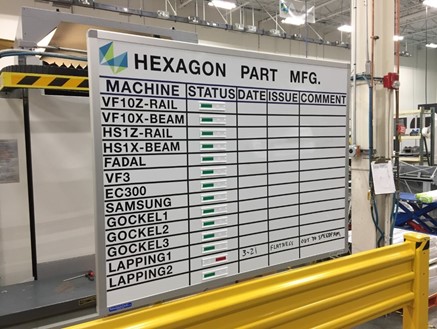Company Profile
Headquartered in North Kingstown, RI, Hexagon Manufacturing Intelligence develops, manufactures, and distributes dimensional metrology hardware, software, and accessories. The company’s products boost efficiency, productivity, and quality across industrial, manufacturing, infrastructure, safety, and mobility applications throughout the United States and across the globe.
Situation
Hexagon was experiencing unscheduled equipment downtime on their CNC milling machines. True to the company’s mission, Senior Manufacturing Engineer Brian Malloy wanted to gather measurements that would help the team understand what was happening by applying Six Sigma principles utilizing the DMAIC (Define-Measure-Analyze-Improve-Control) method.
Hexagon reached out to Polaris MEP and project manager Phil Ward. “I have limited bandwidth as an engineer. Having Polaris MEP as a partner allowed us to have our resources work on other projects that also contributed to generating revenue.”
The team started with one CNC machine, observing both operations and maintenance personnel. Ward and Malloy reviewed the machine performance metrics, maintenance records, replacement parts usage and spare parts inventory.
Data revealed that maintenance was inconsistent and often not aligned with machine’s true requirements. Lack of knowledge led to material waste, repeated calls to external specialists and machine downtime. Ownership of the problem also was not clear to Production Management or Facilities.
IMPACTS
| Approximately 240-labor hours saved/yr: ~$12K annually | ||
| year-to-date savings of $8K = roughly $14K/yr | ||
| Throughput increased 15% | ||
| 77% reduction in downtime for maintenance 8% increase in uptime |
“The operators are enthusiastic – they don’t want to deal with breakdowns and downtime. The production manager is very enthusiastic – he’s getting more throughput with less cost. It wouldn’t have happened in the timeframe defined without the Hexagon/Polaris MEP team approach.”
Brian Malloy
Senior Manufacturing Engineer, Hexagon Manufacturing Intelligence
Solution
The Hexagon/Polaris MEP team collaborated with CNC machine suppliers to document recommended maintenance procedures and frequencies. The team developed Standardized Work Instructions (SWI) that reflected the true requirements and a Gantt chart of tasks that is posted monthly.

Finally, Ward created a Visual Management System for the department. This Lean tool promotes OLPC – operator led process control.
“This board was an improved method to more easily assess the operational status of the Part Manufacturing Department and to solicit input. Operators appreciate having a heightened level of ownership and responsibility in the process,” said Malloy. “They’re fully engaged. If they identify an operational issue or improvement opportunity, they’ll share that with a manufacturing engineer.”
A side effect of the pilot was organization of the spare parts inventory. Lack of understanding often meant urgent calls to specialists for needed items or downtime while waiting for parts delivery. “Now knowing exactly what we need to do long term, we know what parts have to be on hand to allow facilities to do their job,” said Malloy. “This was an added benefit. It was an outcome we hadn’t planned on.”
The process has been repeated with all CNC’s within Hexagon’s Part Manufacturing Department. “We now have a documented historical system in place to define both what the expectations are, when they are to be completed and by whom,” said Malloy. “I can tell you the last time we changed a filter, performed lubrication or cleaned the turret on a machine, etc.”
Results
Malloy says his intent for the project was to understand and cut costs, not to generate revenue or increase Hexagon’s throughput – but both “side benefits” resulted.
Cost savings were realized both in raw material costs and work hours. The facilities team had been performing maintenance on weekends to try to reduce impact on production. These overtime hours were eliminated with SWI.
Malloy provided an example of material savings. “Cutting fluid was being dumped every two weeks, when analytical testing confirmed an alternative dump frequency of eight to twelve months was attainable. That one change saved Hexagon $24,000 annually in cutting fluid costs.”

